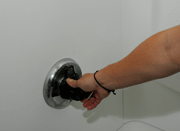Finding Leaks before the Flood

You've probably had an experience when a small drip became a big leak. Even small indoor leaks can damage drywall, cabinets, flooring and carpet. The best way to avoid water damage and unnecessary floods in your home is to plan ahead. Know where and how to look for leaks.
Pay attention to your water bill
Use your water bill as a leak-detection tool. If you notice an unexpected surge in water use or cost, you may have an indoor leak or
outdoor leak.
Look, listen and plan ahead
Plan to look and listen for indoor leaks on a regularly-planned schedule (the first of the month or each time you pay your water bill). That drip you hear at night can waste up to 600 gallons of water per month.
Plan a quick monthly or bi-monthly inspection of water-using appliances and fixtures. To make repairs easy, keep a handy leak-repair tool kit (include plumber's tape, an adjustable wrench, plumbing lubricant and replacement washers).
Where to look?

On ceilings and walls
Don't ignore damp spots and water marks on ceilings and walls. Ignored leaks can cause extensive structural damage to your home. Consult a plumbing professional if you suspect a hidden leak.
Under the lid and in the tank
If you suspect a leak, run as fast as you can to your toilet. If the toilet is running - it's leaking! However, be prepared that silent toilet leaks can go undetected. To be on the safe side, place a few drops of blue food coloring in your toilet tank. Do not flush. If after 10 to 15 minutes you have blue water in the toilet bowl, a worn-out seal around the flapper is leaking water from the tank to the bowl. It's time to replace the flapper or, better yet, install a
new-generation high-efficiency toilet.
Visit
Literature & Media to order free information on toilet leaks.
Beneath the sink
You're probably hiding cleaning products, rags and sponges in the cabinets beneath your sinks. These items can disguise water build-up from leaky pipes, rinse hoses,
faucets,
dishwashers, ice makers and other water-using appliances in the kitchen and bathroom. Look for damp spots and pay attention to mold and musty odors, as they can be the first hint of hidden under-sink leaks. Many under-sink leaks are easy to fix; however, a Valley plumber can help you with difficult repairs.
In the shower
Taking a short
shower helps save you water. However, that shower may not be as short as you think. When your showerhead drips between uses - you're pouring water and money down the drain.
Leaks most often result from:
Poorly-sealed pipe to showerhead connections; and
Deposit-clogged spray holes that backup water.
Most showerhead leaks can be repaired at little or no cost in a matter of minutes.
Unscrew the showerhead;
Look for evidence of mineral build-up or a deteriorating washer;
Remove mineral deposits by soaking in vinegar or other factory-approved solvent;
Replace damaged washers; and
Wrap plumber's tape across threads before re-installing the showerhead.
Down the drain
If you must bathe in a tub (short
showers use far less water), check that your stopper is working. Simple maintenance saves water and water-heating costs by eliminating the need to fill and refill the tub during use.
Close your bathtub drain and run the water for a few seconds. If water drains with the stopper in place, clean the drain of debris and replace the rubber seal on the stopper.
Behind the washer
Rubber
washing machine hoses can weaken and tear. As water in the hoses is under high pressure, leaks can result in extensive water loss, flooding and thousands of dollars in damage to floors, ceilings and other building infrastructure.
Avoid disasters:
Get in the habit of turning off hot and cold water sources between clothes washing and when you are out of the house - washing machine hoses can break without notice.
Invest in reinforced "no-burst" washing machine hoses that have corrode-free couplings, and longer than standard lengths to limit stress from stretching.
Inspect water supply/hose connections regularly for leaks, and pry out and replace worn washers (when the machine is fully disconnected from its water source).
Contact an appliance specialist for annual inspections of hard-to-find tub seals, belts, gaskets, pump hoses and other factory parts.
Where can I find out more?
